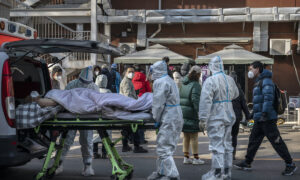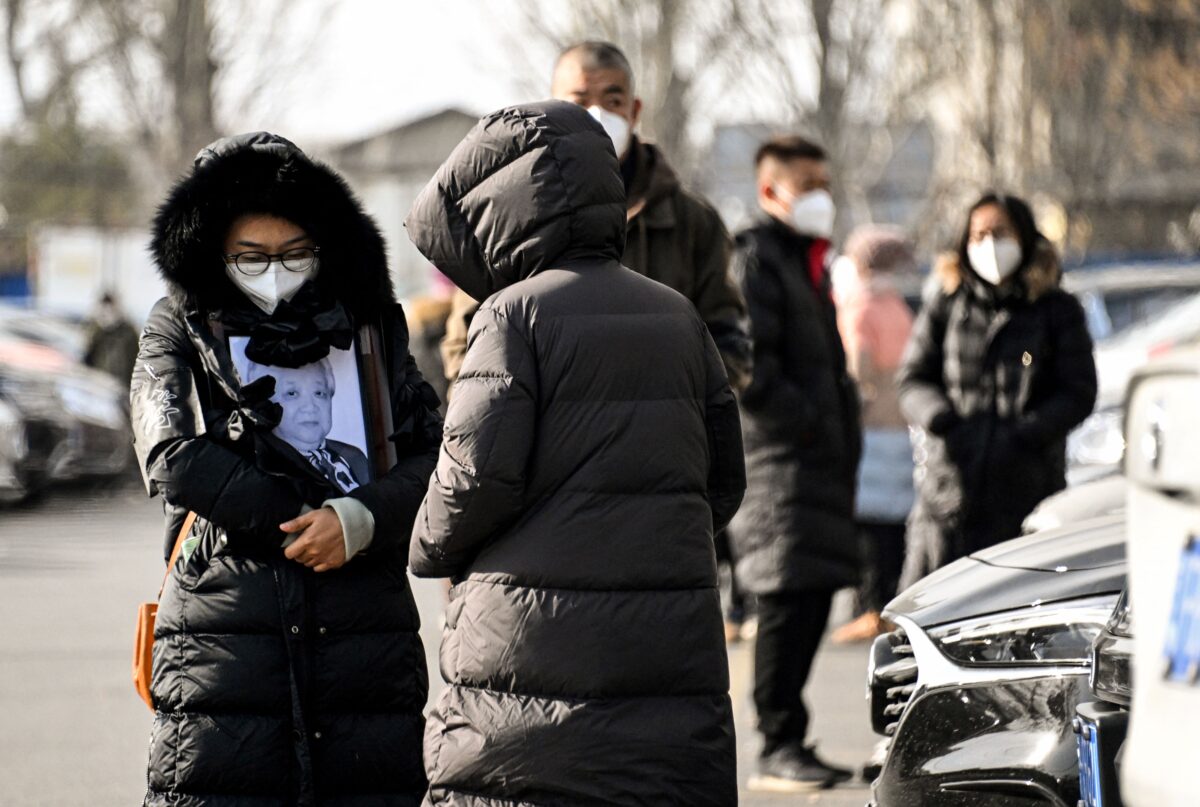The COVID Death Toll Myth in China
CommentaryGeorge Bernard Shaw once said, “Assassination is the extreme form of censorship.” He wasn’t exaggerating a bit. The swift end of Beijing’s zero-COVID policy brought the reported COVID-19 numbers in China closer to reality, but they are still far from commonsensical. Even Hu Xijin, a pro-Beijing propagandist often mocked for his undecorated fawning, conceded via his Twitter account on Jan. 16 that “the actual COVID-19 death toll in China since early December is definitely more than 60,000 because the official data only counted deaths at hospitals.” Perhaps not coincidentally, on the same day, Bloomberg published a story, “China’s Hospital COVID Death Data Just a Tenth of Total Toll.” With an abrupt ending of the zero-COVID policy in early December 2022, China saw an immediate outbreak of Omicron infections throughout the country, infecting at least some 900 million people—80 percent of which had severe symptoms—according to a recent study at Beijing University. Unsurprisingly, this study was censored by Chinese Communist Party (CCP) authorities and was later deleted from all social media platforms. A report by UK-based analytics company Airfinity estimated 3.7 million COVID infections and 25,000 COVID deaths in a single day on Jan. 13, bringing the total death toll to 584,000 since Dec. 7, 2022. The above data, experts fear, is just the tip of the iceberg. Some estimated that the death toll could reach 200 million to 400 million, given the growing infection rate. Zeng Guang, the former chief scientist of China’s Centers for Disease Control and Prevention (CDC), said on Jan. 12 that this pandemic rippled in Beijing, followed by Guangzhou, Chengdu, and Chongqing, but its deadliest peak has not yet arrived. A search of “China COVID cases” on Twitter yields images of hospitals overcrowded with COVID-19 patients and funeral homes packed with coffins. Zeng Guang predicts the pandemic will continue for at least two to three months. Given that China narrowed the definition of COVID-19 mortality to those who died from respiratory failure after contracting the virus, the actual death toll remains a mystery. Reuters reported on Jan. 17 that its reporter had seen a printed government notice at a Beijing hospital emergency department, which stated that doctors should “try not to” write COVID-induced respiratory failure on death certificates. The same Reuters report quoted a doctor at a large public hospital in Shanghai as saying, “We have stopped classifying COVID-19 deaths since the reopening in December. … It is pointless to do that because almost everyone is positive.” According to Pew Research Center, China’s population has suffered a decline in recent years, ceding the title of the most populous country in the world to India. The low birth rate, in addition to the massive death tolls from the SARS and COVID-19 pandemics, has brought down China’s population. A woman holds a picture frame of a loved one at a crematorium in Beijing on Dec. 20, 2022. Workers at Beijing crematoriums said on Dec. 16 they are overwhelmed as China faces a surge in COVID-19 cases. (Noel Celis/AFP via Getty Images) To make up for this sharp population decline, Beijing has, in recent years, been pushing for a two-child policy and now even a three-child policy in an effort to boost its population growth. The once-endorsed one-child policy was officially abandoned in late 2015. Beijing admitted on Jan. 17 that 9.56 million people were born in China in 2022, while 10.41 million people died. In other words, the authorities acknowledged that China had 850,000 fewer people at the end of 2022 than the previous year—the first reported reduction in six decades. Historians have noted that a massive, deadly pandemic like COVID-19 is not new nor unique in light of China’s long history. Oftentimes, pandemics occurred along with dynastic changes. Some 290 serious epidemics were recorded between 243 B.C. and 1911. At least 700 cases of widespread infectious diseases have been identified from the 7th century B.C. to the end of the 20th century in China. From a cultural perspective, both Buddhism and Taoism tend to offer the spiritual interpretation of catastrophic pandemics as karmic retribution. Traditionally, people in China have always treated natural disasters as a form of heavenly punishment and warning for society’s ills. It is much in the vein of Christian belief: you reap what you sow. The recent White Paper Revolution in China has shown that the masses are fed up with the CCP’s coverup and lies, as well as with its inhumane zero-COVID policy, which some say has brought about more deaths than the pandemic itself. On Jan. 11, the World Health Organization (WHO) reiterated that China should be more transparent about its COVID-19 situation. Maria Van Kerkhove, the technical lead for WHO’s COVID-19 response, said, “There are some very important information gaps that we are working with China to fill.” But WHO’s appeal is feeble at

Commentary
George Bernard Shaw once said, “Assassination is the extreme form of censorship.” He wasn’t exaggerating a bit. The swift end of Beijing’s zero-COVID policy brought the reported COVID-19 numbers in China closer to reality, but they are still far from commonsensical.
Even Hu Xijin, a pro-Beijing propagandist often mocked for his undecorated fawning, conceded via his Twitter account on Jan. 16 that “the actual COVID-19 death toll in China since early December is definitely more than 60,000 because the official data only counted deaths at hospitals.”
Perhaps not coincidentally, on the same day, Bloomberg published a story, “China’s Hospital COVID Death Data Just a Tenth of Total Toll.” With an abrupt ending of the zero-COVID policy in early December 2022, China saw an immediate outbreak of Omicron infections throughout the country, infecting at least some 900 million people—80 percent of which had severe symptoms—according to a recent study at Beijing University. Unsurprisingly, this study was censored by Chinese Communist Party (CCP) authorities and was later deleted from all social media platforms.
A report by UK-based analytics company Airfinity estimated 3.7 million COVID infections and 25,000 COVID deaths in a single day on Jan. 13, bringing the total death toll to 584,000 since Dec. 7, 2022.
The above data, experts fear, is just the tip of the iceberg. Some estimated that the death toll could reach 200 million to 400 million, given the growing infection rate. Zeng Guang, the former chief scientist of China’s Centers for Disease Control and Prevention (CDC), said on Jan. 12 that this pandemic rippled in Beijing, followed by Guangzhou, Chengdu, and Chongqing, but its deadliest peak has not yet arrived. A search of “China COVID cases” on Twitter yields images of hospitals overcrowded with COVID-19 patients and funeral homes packed with coffins. Zeng Guang predicts the pandemic will continue for at least two to three months.
Given that China narrowed the definition of COVID-19 mortality to those who died from respiratory failure after contracting the virus, the actual death toll remains a mystery. Reuters reported on Jan. 17 that its reporter had seen a printed government notice at a Beijing hospital emergency department, which stated that doctors should “try not to” write COVID-induced respiratory failure on death certificates.
The same Reuters report quoted a doctor at a large public hospital in Shanghai as saying, “We have stopped classifying COVID-19 deaths since the reopening in December. … It is pointless to do that because almost everyone is positive.”
According to Pew Research Center, China’s population has suffered a decline in recent years, ceding the title of the most populous country in the world to India. The low birth rate, in addition to the massive death tolls from the SARS and COVID-19 pandemics, has brought down China’s population.

To make up for this sharp population decline, Beijing has, in recent years, been pushing for a two-child policy and now even a three-child policy in an effort to boost its population growth. The once-endorsed one-child policy was officially abandoned in late 2015. Beijing admitted on Jan. 17 that 9.56 million people were born in China in 2022, while 10.41 million people died. In other words, the authorities acknowledged that China had 850,000 fewer people at the end of 2022 than the previous year—the first reported reduction in six decades.
Historians have noted that a massive, deadly pandemic like COVID-19 is not new nor unique in light of China’s long history. Oftentimes, pandemics occurred along with dynastic changes. Some 290 serious epidemics were recorded between 243 B.C. and 1911. At least 700 cases of widespread infectious diseases have been identified from the 7th century B.C. to the end of the 20th century in China.
From a cultural perspective, both Buddhism and Taoism tend to offer the spiritual interpretation of catastrophic pandemics as karmic retribution. Traditionally, people in China have always treated natural disasters as a form of heavenly punishment and warning for society’s ills. It is much in the vein of Christian belief: you reap what you sow.
The recent White Paper Revolution in China has shown that the masses are fed up with the CCP’s coverup and lies, as well as with its inhumane zero-COVID policy, which some say has brought about more deaths than the pandemic itself.
On Jan. 11, the World Health Organization (WHO) reiterated that China should be more transparent about its COVID-19 situation. Maria Van Kerkhove, the technical lead for WHO’s COVID-19 response, said, “There are some very important information gaps that we are working with China to fill.” But WHO’s appeal is feeble at best in the eye of Beijing.
As reported by Radio Free Asia, Jiang Yunzhong, the Communist Party secretary for the library of the prestigious Qinghua University, wrote on his social media platform: “What’s the big deal with a few million deaths? In 2021 China had 10 million deaths; another 5 million deaths is merely a 50 percent death number.”
His indifference to the COVID-19 victims has led to public outrage on Chinese social media. Such naked, heartless attitude has, in many ways, reflected that of the CCP leadership toward the value of human life.
What matters to the CCP is to hold onto its political power—at all costs. Chairman Mao Zedong once put it blatantly, “Communism is not love.”
Views expressed in this article are the opinions of the author and do not necessarily reflect the views of The Epoch Times.












